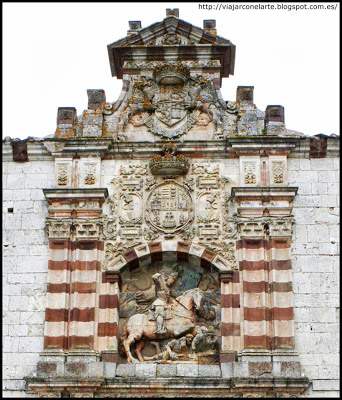Version 1: After James' death, his disciples shipped his body to the Iberian Peninsula to be buried in what is now Santiago. Off the coast of Spain, a heavy storm hit the ship, and the body was lost to the ocean. After some time, however, it washed ashore undamaged, covered in scallops.
Version 2: After James' death his body was mysteriously transported by a crew-less ship back to the Iberian Peninsula to be buried in what is now Santiago. As the ship approached land, a wedding was taking place on shore. The young groom was on horseback, and on seeing the ship approaching, his horse got spooked, and horse and rider plunged into the sea. Through miraculous intervention, the horse and rider emerged from the water alive, covered in seashells.
The scallop shell also acts as a metaphor. The grooves in the shell, which meet at a single point, represent the various routes pilgrims traveled, eventually arriving at a single destination: the tomb of James in Santiago de Compostela. The shell is also a metaphor for the pilgrim: As the waves of the ocean wash scallop shells up onto the shores of Galicia, God's hand also guides the pilgrims to Santiago.
The scallop shell also served practical purposes for pilgrims on the Camino de Santiago. The shell was the right size for gathering water to drink or for eating out of as a makeshift bowl.Personally, the romantic in me likes the second explanation better--who doesn't like a good love story? However, the real reason is probably more simple than that: shells are ubiquitous on the coast of Northern Spain, and pilgrims used to pick them up and take them home as souvenirs of their travels. Whatever the reason, I now have my own shell to mark me as a pilgrim, a Peregrina.
Notice the Santiago Cross, though...if you look at it, it looks a little like a stylized sword. I was talking with a friend who let me borrow a statue of St. James, and because he was carrying a sword, I thought he might be a depiction of Santiago de Matamoros, or St. James the Moor Slayer. However, my friend said that St. James is often depicted with a sword, since he was beheaded.
 |
| This is Santiago de Matomoros: he is always on a horse that is trampling a Moor while wielding a sword. This particular statue is on one of the buildings in Burgos, where I will begin my Camino. |
And yet, isn't that what all of us are called to be: both pilgrims and soldiers? Think about it--we here on earth are called the "Church Militant," because we are in a spiritual battle, and that means that we have to be willing to strap on our armor and get on with the battle. Granted, that doesn't mean slaying actual people most of the time, but it does mean that we have to be willing to engage the enemy of our souls. So, as I leave for pilgrimage (TOMORROW!!!), please pray for me, and don't stop praying. We will battle together, even as I take this journey that God has placed my feet upon. And so, as I set my feet on this path, let me leave you with a snippet from one of my favorite Tolkein Poems:
The Road goes ever on and onBlessings,
Down from the door where it began.
Now far ahead the Road has gone,
And I must follow, if I can,
Pursuing it with eager feet,
Until it joins some larger way,
Where many paths and errands meet.
The Road goes ever on and on
Down from the door where it began.
Now far ahead the Road has gone,
And I must follow, if I can,
Pursuing it with weary feet,
Until it joins some larger way,
Where many paths and errands meet.
And whither then? I cannot say.
Ruth



No comments:
Post a Comment